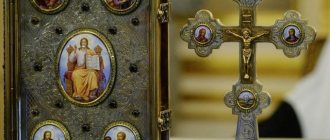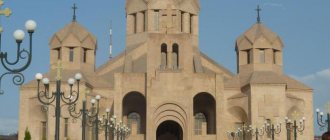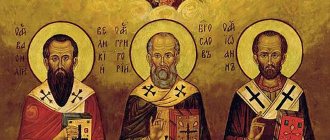Ostromir Gospel
That day, May 25, 1057, was a significant day for Deacon Gregory: he held in his arms, like a child, work into which he had invested a part of himself, his soul, work done with great zeal for the Glory of God. This was the Gospel.
Commissioned by the Novgorod mayor Ostromir (baptized Joseph), the manuscript was skillfully decorated with miniatures and headpieces and written in large calligraphy in two columns. The creation of such a work was beyond the power of one person - Deacon Gregory worked together with assistants.
How much attention and diligence the copyist’s work alone required can be judged by the note addressed to the readers: “Don’t curse, but read it correctly.” — The creators of the book, according to the custom of that time, thus asked for forgiveness for possible errors made during the rewriting of the text.
An amazing fate awaited this manuscript - it outlived its owner and compilers by 900 years, it became one of the seven unique monuments of the ancient Russian book of the 11th century, along with the Kyiv Izborniki 1073 and 1076, the Archangel Gospel of 1092 and three Novgorod lists of Menaions.
And yet, being the oldest accurately dated Slavic book, the Ostromir Gospel is the “cornerstone” of the written culture of Rus' and the Slavic peoples close to it, a monument of world significance.
The preservation of this ancient book is very symbolic: it was the Gospel, according to the definition of one of the modern researchers, Yuri Loshits, that was “the very first book in the circle of Russian reading, the very first ancient Russian liturgical, and then home reading, as well as the very first common Slavic reading.”
If it had not been our first reading, then we probably would not have known “The Idiot” and “The Brothers Karamazov” by Dostoevsky, “The Enchanted Wanderer” by Leskov, and would not have recognized the gospel robber in Pushkin’s penitent Pugachev. We would have neither Ivanov’s “Appearance of Christ to the People,” nor the gospel stories of Ge, Kramskoy and Polenov, nor liturgical musical works. This list could go on and on. And it will be continuous evidence of the exceptional significance that the Gospel has received not only in the church life of Russia, but also in Russian culture as a whole. Moscow Metropolitan Filaret (Drozdov) called the Gospel “eternal news.”
The Ostromir Gospel is preserved in Russia as a great shrine. Having disappeared from view for entire centuries, in the 18th century. it seemed to have revealed itself, to have come as a message from Holy Rus' - Peter’s Russia, “young”, but not successful spiritually, communicating the blessing of the Lord to the Orthodox people in political trials. One of the oldest records on this book - “Gospel of Sophia aprakos” - indicates that it was once in the Novgorod St. Sophia Cathedral.
Initial letters from the Ostromir Gospel.
When in 1701 Peter I issued a decree to review and rewrite “letters of letters... and historical books” in cathedrals and monasteries, and send the lists to the Senate, in the inventory of the property of one of the churches of the Moscow Kremlin, this treasure of ancient Russian writing was discovered. In 1720, the Ostromir Gospel was sent to the new capital of the empire.
The next news about this unique book dates back to 1805. Ya. A. Druzhinin, the former personal secretary of Catherine II, found, while sorting through the things of the late empress, a handwritten Gospel, which “was not written down anywhere in the inventory or in the parish and therefore it is unknown how long ago and from whom” came to the palace.
On the last, 294th page of the book, an entry by Deacon Gregory was discovered, thanks to which it was possible to establish the time of its completion. The “blessing” of Holy Rus' did not leave the country even in the difficult 30s for the Church. — In 1932, despite the fact that this rare book was always under the special supervision of employees of the State Public Library, it was stolen directly from the display case, where it had been lying for 80 years.
Fortunately, the thieves of the Ostromir Gospel were not experts in ancient Russian books. They were seduced by the massive silver frame. Having torn off the precious frame, the robbers threw the manuscript onto one of the nearby cabinets, which they confessed to on the same day, having been caught red-handed.
In 1957, the State Public Library celebrated the 900th anniversary of the Ostromir Gospel. By this date, the unique handwritten book was restored. The work lasted more than six months. The most experienced restorers decided not to bind the manuscript: the sheets were sewn with surgical silk, and this greatest monument of Orthodox culture was placed in a specially made case made of old oak.
Dozens of monographs by major Russian philologists, experts in ancient Russian bookmaking, paleographers, linguists, miniature specialists and even musicologists are devoted to the study of the text of the Ostromir Gospel, since the book contains a large number of so-called. ekphonetic signs intended for readers and indicating the proper rhythm of reading.
According to the expert on ancient Russian book art N.N. Rozov, “the Russian book from the very beginning of its existence should be considered as a synthesis of verbal and visual art.” N.M. also turned to the Ostromir Gospel as a valuable historical source. Karamzin. Quoting the “Afterword” of Deacon Gregory on the pages of the “History of the Russian State,” he pointed out that the date of death of Ostromir, who ordered the book, which is given in later Russian chronicles, is erroneous.
As a most valuable monument of the Church Slavonic language, the Ostromir Gospel began to be published by the largest Russian scientists of the 19th-20th centuries. The curator of the Department of Manuscripts of the Imperial Public Library, Alexander Khristoforovich Vostokov (1781-1864), having carefully studied the text, in 1820 published a monumental study - “Discourse on the Slavic Language”, suggesting that it dates back to the translation of the Slavic first teachers Cyril and Methodius.
In the Gospel of Matthew there are lines that can be attributed not only to spiritual gifts, but also to great shrines: “When you light a candle, you do not put it under a bushel, but on a candlestick, and it gives light to everyone” (Matthew 5:15).
To this day, the Ostromir Gospel is in the Russian National Library in St. Petersburg. Since it is one of the most precious monuments of world culture, only the custodians of this book and the most experienced scholars have access to it. But, being a most valuable example of the spiritual and written culture of Ancient Rus' and the entire Slavic world, it should one day become more accessible to people who want to familiarize themselves with the text. The first experience of copying text took place in the 18th century, when the keeper of ancient manuscripts of this library A.I. Ermolaev, in order not to disturb the most precious book once again, made an exact copy of it.
In 1883, a photolithographic publication of the Ostromir Gospel was undertaken. But only the miniatures and the first splash screen were reproduced in color. And so, in 1988, on the occasion of the celebration of the 1000th anniversary of the Baptism of Rus', a facsimile edition of the Ostromir Gospel was published. Five thousand copies of this publication have been distributed around the world, and now many lovers of ancient Russian literature have the opportunity to study this monument of Orthodox literature.
As noted by N.P. Polevoy in his “History of Russian Literature,” published in 1900: “In this precious manuscript we possess the greatest treasure: both in the sense of antiquity and in the sense of the external beauty of the monument - this is a wonderful example of the written art of our ancestors. None of the Slavs, except us Russians, had the good fortune to preserve such a monument from their handwritten antiquity.”
Source
Ostromir Gospel: past, present and future
The Ostromir Gospel is the oldest dated Russian handwritten book that has survived to this day.
It stands at the origins of the thousand-year development of our culture. According to His Holiness Patriarch Alexy II of Moscow and All Rus', “both in ancient times and now it unites people around the name of Christ the Savior and is an enduring spiritual symbol of Russia.” From October 29 to November 1, 2007, an international scientific conference dedicated to the 950th anniversary of the Ostromir Gospel was held at the Russian National Library in St. Petersburg. The conference at the National Library of Russia continued the ceremonial events of the anniversary year: on April 9, 2007, on the bright days of Easter, the Ostromir Gospel was for the first time in many centuries at the service in St. Isaac's Cathedral in St. Petersburg. Many people were able to venerate this shrine and, with a sense of reverence, feel their involvement in the Christian cultural heritage.
The anniversary of the unique monument caused a great public outcry, bringing together representatives of government authorities and the Russian Orthodox Church, outstanding scientists, cultural figures and industrialists. The conference at the National Library of Russia showed once again that there are areas where state, religious and scientific interests come together. This is the preservation of cultural traditions, education and protection of the morality of the people.
The Ostromir Gospel is a pearl of medieval literature. “In this precious manuscript we have the greatest treasure: both in terms of antiquity and in the sense of the external beauty of the monument: it is a wonderful example of the written art of our ancestors. None of the Slavs, except us Russians, had the good fortune to preserve such a monument from their handwritten antiquity,” wrote the historian of Russian literature N.P. in 1900. Field. In the 80s of the 19th century, at the expense of the merchant Ilya Savinkov, a photolithographic edition of the Ostromir Gospel was undertaken. This publication made the monument widely known in Russia: in secondary and higher educational institutions they read texts from it when studying the Old Church Slavonic language. Every high school student could answer the question about the Ostromir Gospel.
What now? It cannot be said that the Ostromir Gospel is widely known to our contemporaries. The overwhelming majority of Muscovites surveyed (church people, with higher education, not alien to an interest in history) either know nothing at all about the first Russian book, or have the most vague ideas, at best believing that it is something like “The Tale of Igor’s Campaign” or "Tales of Bygone Years." But the Ostromir Gospel is a witness to our thousand-year history, a book that has actually, physically been preserved from ancient times to the present day. It connects us with a living thread to the era of the beginning of Russian bookishness, statehood and holiness. Alas, Pushkin’s bitter words: “We are lazy and incurious,” could not be more applicable to our time.
We live in an era of poor historical education, which is being successfully replaced, according to the definition of the famous 20th-century theologian Archimandrite Sophrony (Sakharov), by a “culture of sin”, aggressively imposed on people. Our people can only be saved from this “culture,” and therefore from inevitable corruption and savagery, by joining the centuries-old culture of Orthodoxy, the basis of which is the Gospel of Christ. “When we look at the Ostromir Gospel, the great reverence that our forefathers felt for their faith becomes obvious. Their efforts were the result of touching the Spirit that lives in the Holy Scriptures, which acts in the Church and really changes human life,” is the opinion of Archbishop Konstantin of Tikhvin, rector of the St. Petersburg Theological Academy and Seminary.
Since the time of their baptism, the Russian people have deeply and soulfully accepted Orthodoxy and the book culture associated with it. The oldest Russian chronicle, “The Tale of Bygone Years,” reports that Prince Vladimir laid the foundation for book education: he himself revered “bookish words” and began to teach the children of the best people. Vladimir’s son, Prince Yaroslav the Wise, who, according to the chronicler, “loved books, reading often both night and day,” gathered “many scribes in Kyiv, and they translated from Greek into Slavic. And they wrote many books, from which believers learn and enjoy the Divine teaching.” The books in The Tale of Bygone Years are called “sources of wisdom”, “rivers that water the entire universe.”
The Ostromir Gospel was created during the era of cultural upsurge and the formation of statehood in Ancient Rus', which followed the adoption of Christianity in 988. On the last page of the manuscript there is an afterword by the scribe, Deacon Gregory. It states that work on the manuscript began on October 21, 1056 and was completed on May 12, 1057. The dates indicated by the scribe, according to most researchers, are not accidental. October 21 is the day of memory of Hilarion the Great. For the scribe's contemporaries, this name was associated with the name of the Kyiv Metropolitan Hilarion - “a man of goodness, a bookish and fasting man,” the author of the famous “Sermon on Law and Grace.” Vladyka Hilarion was a like-minded person and associate of Yaroslav the Wise and played a vital role in the enlightenment of Rus', in the formation of its national identity and in the organization of book writing at the Kiev St. Sophia Cathedral.
The date of completion of work on the manuscript is also significant - May 12. This date connects the Russian book of the 11th century with Byzantium of the 4th century, when Christianity became the state religion in the empire. Constantine the Great, having founded the new capital of Constantinople, dedicated it to the Mother of God. The feast of dedication was celebrated in Byzantium on May 11, 330 (later this day was celebrated as the day of the Renewal of St. Sophia of Constantinople). And on May 12, the first Christian churches in Rus' were consecrated - the Tithe Church (995) and St. Sophia Cathedral (1045) in Kyiv. It is significant that on these same days the memory of Saints Equal-to-the-Apostles Cyril and Methodius is celebrated, with whose names the emergence of Slavic writing is associated.
All this leaves historians with no doubt that during the creation of the Ostromir Gospel a deep concept was developed that introduced this book, and with it the ancient Russian state, into the mainstream of world Christian culture. This concept of the unity of Rus' with the entire Christian world is manifested not only in the symbolism of these dates, but permeates all the main elements of the monument: its language, text, decoration.
In the afterword, Deacon Gregory reports that he rewrote the Gospel by order of the Novgorod mayor Ostromir, in the baptism of Joseph, during the reign of the Kyiv prince Izyaslav (1024–1078, son of Yaroslav the Wise). The high position of the customer of the book, Ostromir, a representative of one of the most influential Russian families, is especially emphasized: his grandfather Dobrynya (the epic Dobrynya Nikitich) was the uncle of the holy prince Vladimir the Red Sun and actively participated in the baptism of Rus'. The scribe glorifies the Novgorod mayor and his wife Feofana and prays to God to grant them and their children and their spouses long life. Feofana, undoubtedly, was also a distinguished person: her Greek name speaks of her aristocratic origin. There is an opinion, which, however, is not shared by all historians, that she was the daughter of the Great Equal-to-the-Apostles Prince Vladimir and the Byzantine Princess Anna, and therefore the sister of the first Russian saints - Princes Boris and Gleb, the half-sister of Grand Duke Yaroslav the Wise and the aunt of Grand Duke Izyaslav , whose confidant was Ostromir.
The Novgorod mayor was not destined to have a long life. Brave and decisive, he soon (around 1060) died in a campaign against the Chud tribe, leading his squad. However, Ostromir's name was forever associated with the book he ordered.
Deacon Gregory does not name the places where he copied the book. It is believed that this could be both Kyiv and Novgorod. Both versions have their scientific supporters. The rich decoration and excellent state of preservation of the ancient codex indicate that it was not intended for daily family use. In terms of the content and structure of the text, the Ostromir Gospel is a short aprakos, that is, it belongs to liturgical books. The main body of the text contains daily Gospel readings from Easter to Pentecost, as well as Saturday and Sunday readings for the following weeks. The second part includes gospel readings for the month, starting in September, as well as a number of additional readings for various occasions (for the consecration of the church, “for the victory of the king in battle,” for the sick, etc.).
Of particular interest is the monthly part of the codex: it contains the memories of saints not only of the Eastern, but also of the Western Church. This gives grounds for a number of researchers to believe that the Ostromir Gospel is perhaps the last liturgical monument that has survived to this day, reflecting the unity of the Christian Church. The reason for the unusual composition of the monthly book is also seen in the features of the protograph - that handwritten book that served as the original for the creation of the Ostromir Gospel. The broad dynastic ties of the Kyiv princely house, which spread throughout the world, are also important. It was no coincidence that Yaroslav the Wise was called the “father-in-law of Europe”: of the 38 marriages of the Rurikovichs in the 11th century, eight cases occurred in Germany, two in France, five in the Scandinavian kingdoms and England, seven in Poland, six in Hungary, three marriages with Polovtsians princesses, one with a Byzantine princess, two with representatives of the Byzantine aristocracy. This largely explains the breadth of cultural orientation and the unique combination of different traditions in the creation of the book.
The Ostromir Gospel was probably intended by the customer as a precious contribution to the St. Sophia Cathedral - the main temple of northwestern Rus', which was erected in 1045–1050. in Veliky Novgorod on the model of Sophia of Kyiv (this temple was founded in 1037).
The belonging of the manuscript to the St. Sophia Cathedral is indirectly confirmed by the entry in 17th century cursive writing on the first page of the book: “Gospel of Sophia aprakos.” The Gospel was used as an altar table and, judging by its condition, for most of its long history it was under especially careful care and remained in the cathedral sacristy - the place where church utensils and vestments are stored.
The perfection of calligraphy and artistic design of the manuscript speaks of the high art of the book of that time. According to the greatest expert on ancient Russian book art N.N. Rozov, “the Russian book from the very beginning of its existence should be considered as a synthesis of verbal and visual art.” In the monuments of ancient writing, one is struck by the amazing harmony, proportionality of all elements of the text and design, and their joyful colorfulness.
The Ostromir Gospel is written on high-quality parchment - specially treated skin of young animals (usually calves). Making thin and smooth parchment required a lot of effort. At first, this expensive material was brought to Rus' from Byzantium. The manuscript is written in a “charter” - a style dating back to the Byzantine uncial letter. It is characterized by special clarity and rigor of the characters. This type of writing requires high scribe skill and considerable time, since each element of the letter is written in a separate movement with the pen being lifted from the parchment.
Initial letters of the Ostromir Gospel
The general design of the Ostromir Gospel, with two-column text, titles in gold, spacious margins and numerous patterns, generally follows the Byzantine tradition. The manuscript is decorated with three miniatures depicting the evangelists John, Luke and Mark. The miniatures of the Ostromir Gospel are executed in two different manners: John and his disciple Prokhor differ from Luke and Mark, who are very similar to each other. Particular attention of researchers is attracted by the unique iconography of the miniature with John the Evangelist. At the top, outside the frame framing this miniature, there is a lion, clearly highlighted by the artist in size and location and differing from the traditional image of the evangelist (usually the lion symbolizes the Evangelist Mark). This image has many meanings: first of all, it is a symbol of Christ himself. Ostromir's Gospel begins with a reading on the first day of Easter, in the hymns of which the risen Christ is compared to an awakened lion. The allegory “lion - Christ” was very popular in Western art, and was also found in Byzantine art, although such an image is absent in other Aprakos Gospels, Greek and Russian. But the lion is also a traditional Byzantine imperial symbol. And this is very consistent with the status of the customer of the manuscript, mayor Ostromir, and his wife Feofana (remember her probable relationship to the Byzantine imperial house). There is also no doubt that the high symbolism emphasizes the national significance of the book itself.
In addition to miniatures, the manuscript is decorated with ornaments for various purposes: colorful headpieces, text dividers and many initials placed on the sheets at the beginning of the readings and having a large size, much larger than is usually the case in Byzantine manuscripts. The patterns of the Ostromir Gospel belong to the so-called “enamel” or “petal” type of ornament: stems and petals of flowers, combined in various combinations and having a thick, dense coloring, similar to enamels. The decor of the book, according to the prominent Byzantine art critic O.S. Popova, even surpasses the Greek codes of that time in brightness and effectiveness.
The initials of the Ostromir Gospel, and there are more than two hundred of them, are the subject of special attention of researchers. Along with the traditional elements of the ornament, there are often completely unusual anthropomorphic images inscribed in the composition of the letters - round and ruddy faces, somewhat reminiscent of the image of the sun or Romanesque stone masks. There is nothing like this in either the Greek or Latin manuscripts. The bizarre zoomorphic initial letters decorating the text are also amazing. The originality of the initials of the Gospel testifies to the deep mastery by its creators of both Eastern and Western traditions of book decoration and an attempt to creatively combine them in the design of the Russian codex.
Initial letters of the Ostromir Gospel
Another rare feature of the manuscript is the presence of ekphonetic signs indicating how the text should sound in a divine service. The reading of the Gospel in the Church was especially solemn, “for all to hear.” It was close to singing and was subject to certain rules borrowed from Byzantine practice. Ekphonetic signs mark accents, length of sounds, determining their melodiousness, and also indicate the division of the text into phrases.
Experts tried to decipher these signs and compared them with the liturgical practice of modern Old Believers, which is particularly conservative. The comparison led to striking results: it showed the identity of phrasing and the coincidence of stops when dividing the text into fragments, that is, the continuity of the singing tradition from the 11th century to the present day.
A major researcher of ancient Russian culture G.M. Prokhorov, in his speech at a conference dedicated to the Ostromir Gospel, defined the current ethnocultural situation as follows: “As an integral historical and cultural phenomenon, Ancient Rus' existed until approximately the end of the 17th century. But has she disappeared? No, she didn't disappear. It was dispersed, scattered throughout our country and throughout the globe. Old Believers are a biophysical remnant of Ancient Rus'. Books from our wonderful manuscript collections are a physical remnant of Ancient Rus'. By studying them, we give life to Ancient Rus' in the noosphere - in our minds.”
Currently, the Ostromir Gospel is in the Russian National Library in St. Petersburg. According to the General Director of the Russian National Library V.N. Zaitsev, “it is symbolic that the first Russian book is now stored in the first state book depository of Russia, opened “for the common benefit” in 1814. The role of libraries in the history of mankind is enormous: if a people does not have books, if there are no written monuments left, then this people itself does not have its own history and is doomed to disappear without a trace in the darkness of centuries.”
Photolithographic edition-copy of the Ostromir Gospel of 1889.
The fate of the unique book is known only in general terms. Probably, for several centuries it was kept in the St. Sophia Cathedral of Veliky Novgorod, then it was taken to Moscow: the Ostromir Gospel was indicated in the inventory of the property of one of the churches of the Moscow Kremlin, compiled in 1701. In 1720, the Ostromir Gospel was sent to the new capital of the Russian Empire - St. Petersburg, where, by order of Peter I, materials for Russian history were collected. Here his traces are lost again. In 1805, the manuscript was discovered by Y.A. Druzhinin, personal secretary of Catherine II, among the property of the late empress, who during her lifetime showed great interest in Russian history. In 1806, Emperor Alexander I transferred the Ostromir Gospel to the Public Library, to the manuscript depot (the current manuscript department of the National Library of Russia). From this moment begins the history of storage and research of a unique monument.
In order to expand access to the study of the monument without damaging the original, the curator of manuscripts of the library A.I. Ermolaev made an exact handwritten copy of it, essentially repeating the work of the ancient Russian scribe. Soon the Ostromir Gospel was used as a historical source by N.M. Karamzin, who used it to clarify the date of death of mayor Ostromir. The study of the monument laid the foundation for Russian paleography, a science that deals with ancient manuscripts. An outstanding paleographer was Ermolaev’s successor as custodian - A.Kh. Vostokov. He owns the first scientific essay on the grammar of the Old Church Slavonic language, entirely based on the study of the language of the Ostromir Gospel. In this work, the sound meaning of two mysterious letters of the old Cyrillic alphabet - large and small yus - is indicated for the first time. Relatively few ancient manuscripts written in Cyrillic use these letters correctly. The Ostromir Gospel is one of them. A comparison of the corresponding words of this manuscript with Polish forms prompted Vostokov to guess that the Old Church Slavonic language had nasal vowels and that yuses served to convey them. In 1843, a scientific edition of the Ostromir Gospel prepared by Vostokov was published, which evoked a lively response from Slavists in many countries. Reviews and reviews of this publication were published in Czech, Bulgarian, Polish and Serbian. In the 80s of the 19th century, at the expense of the merchant Ilya Savinkov, two photolithographic editions of the Ostromir Gospel were undertaken, which opened the monument to all of Russia.
Setting of the Ostromir Gospel
The original binding of the manuscript has not survived. In the middle of the 19th century, according to a sketch by I.I. Gornostaev, a massive, richly decorated frame was made. However, it did not have the best effect on the condition of the parchment sheets. In addition, he attracted the attention of robbers, who in 1932 stole the manuscript from the display case where it was on display. Fortunately, the unlucky kidnappers were only seduced by the impressive salary. Having torn off the binding, they threw the manuscript onto one of the library cabinets, which they admitted to, being caught on the same day. Since then, for better preservation, the precious book has been kept unbound in a special casket made of bog oak and locked in a safe. For the current anniversary, a new depository has been manufactured that meets all modern storage standards.
In 1957, the 900th anniversary of the Ostromir Gospel was solemnly celebrated. By this date, the unique handwritten book had been thoroughly restored. The restoration work, which lasted more than six months, was led by E.Kh. Trey. At the same time, experts put forward the task of facsimile publication of the Ostromir Gospel.
This publication was prepared with the leading participation of N.N. Rozov and the support of the Publishing Department of the Moscow Patriarchate. A facsimile edition of the Ostromir Gospel, equipped with a scientific apparatus, was published in 1988, on the 1000th anniversary of the Baptism of Rus', and currently plays the role of the main copy of the monument, providing access to it to a wide range of researchers and readers without resorting to the priceless original.
Just like 50 years ago, the current anniversary celebrations are accompanied by exhibitions at the National Library of Russia. A virtual exhibition “The Ostromir Gospel and the Handwritten Tradition of New Testament Texts” has been launched on the library’s website, which contains a full information disclosure of the Ostromir Gospel as a monument of world culture and allows you to get acquainted with outstanding examples of manuscripts stored in the National Library.
The anniversary of the oldest Russian book aroused keen interest in the scientific world. Many questions about the history of the writing and existence of the monument (the identity of the scribe Deacon Gregory and his assistants, the place of creation of the manuscript, the question of the protograph and its relationship to the most ancient Slavic translations, the history of the monument before its placement in the manuscript department, etc.) still remain open and await their researchers . But the main thing that all participants in the anniversary celebrations felt was the enormous significance of the Ostromir Gospel for our people. According to His Holiness Patriarch Alexy II of Moscow and All Rus', “today we are all responsible for the fate of the Fatherland, for its present and future, which is largely determined by the attitude of the people to their spiritual roots and cultural traditions.”
“The enormous scientific potential that has been accumulated by scientists must be popularized,” says Professor I.V. Pavlov. “Ahead lies a new ministry of Ostromir’s Gospel to the Russian state, the Russian Orthodox Church, and the people of Russia.”
Ostromir Gospel
Ostromir Gospel
- the oldest surviving Russian handwritten book.
The bulk of the book was created in seven months between October 21, 1056 and May 12, 1057.
Place of writing:
Novgorod the Great.
Census taker:
Deacon Gregory.
Novgorod mayor Ostromir.
The title of the book comes from the name of the customer - Ostromir - Novgorod mayor, a close relative of Grand Duke Izyaslav, son of Yaroslav the Wise.
Old Russian mayor - city mayor, princely governor. He was in charge of defense and justice.
Russian National Library, St. Petersburg.
In 1806, Emperor Alexander I transferred the manuscript of the Gospel, found among the belongings of Catherine II, for storage to the Imperial Public Library, now the Russian National Library, where it is still kept.
Thanks to the afterword of the manuscript
scientists can say exactly where, when, by whom and under what circumstances the Ostromir Gospel was written:
Glory to you, Mr. and ts(ar)yu n(e)b(e)snyi, for like me to write eu(an)g(e)lie, now I have stopped writing. In the year (o) 6564. And at the end of the year (o) 6565. Wrote the same eu(an)g(e)lie to this rabou b(o)zhy being named in the birth of Joseph and the worldly ostromir to the close being Izyaslav knyazou. Izyaslav, the prince, then presented both powers and the father of his Yaroslav and his brother Volodymyr, and the prince himself ruled the table of his Yaroslav in Kiev. And entrust your brother to rule your close one in a new city.
AZ GREGORIY DIAKON(Y) write eu(an)g(e)lie e and write something much worse than this, then don’t let me stare at you and I’m a sinner. stopped writing m(e)s(ya)tsa October 21. And ended m(e)s(ya)tsa Maya at 12
The Ostromir Gospel is an aprakos gospel.
This is a liturgical book in which the texts are divided into passages and arranged in the order of their reading in church on Sundays and holidays, starting with Easter.
It was the liturgical Gospel of the St. Sophia Cathedral of Veliky Novgorod.
Only a rich person could afford a handwritten book. The Novgorod mayor Ostromir ordered the liturgical Gospel “to console many Christian souls.” Most likely, he donated it for the main temple of the city, where he was mayor - St. Sophia of Novgorod.
The restrained proportions of the figures in the miniatures, pronounced hand gestures, and the style of the events depicted are reminiscent of the paintings of Sophia of Kiev, which confirms the hypothesis about the metropolitan origin of the masters of the Gospel.
Months of the Gospel
contains the names of saints of both the Western and Eastern Churches. The manuscript was created just two years after the division of the Churches into Orthodox and Catholic in 1054.
Excerpts from the Ostromir Gospel were included in the compulsory curriculum of pre-revolutionary schools.
In 1843, the Ostromir Gospel was published with the appendix of a brief grammar, dictionary and Greek interlinear text.
Source





